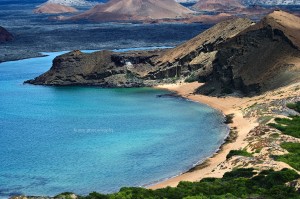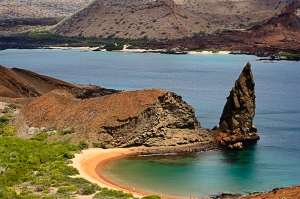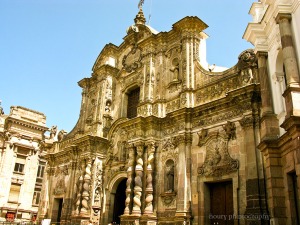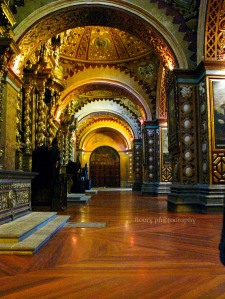 The origin of the Christmas tree is obscure. According to Christian lore, the Christmas tree is associated with St Boniface and the German town of Geismar. Sometime in St Boniface’s lifetime (c. 672-754) he cut down the tree of Thor in order to disprove the legitimacy of the Norse gods to the local German tribe. St. Boniface saw a fir tree growing in the roots of the old oak.
The origin of the Christmas tree is obscure. According to Christian lore, the Christmas tree is associated with St Boniface and the German town of Geismar. Sometime in St Boniface’s lifetime (c. 672-754) he cut down the tree of Thor in order to disprove the legitimacy of the Norse gods to the local German tribe. St. Boniface saw a fir tree growing in the roots of the old oak.
The custom of erecting a Christmas Tree can be historically traced to 15th century Livonia (present-day Estonia and Latvia) and 16th century Northern Germany. According to the first documented uses of a Christmas tree in Estonia, in 1441, 1442, and 1514 the Brotherhood of the Blackheads erected a tree for the holidays in their brotherhood house in Reval (now Tallinn). At the last night of the celebrations leading up to the holidays, the tree was taken to the Town Hall  Square where the members of the brotherhood danced around it. In 1584, the pastor and chronicler Balthasar Russow wrote of an established tradition of setting up a decorated spruce at the market square where the young men “went with a flock of maidens and women, first sang and danced there and then set the tree aflame”. In that period, the guilds started erecting Christmas trees in front of their guildhalls: Ingeborg Weber-Kellermann(Marburg professor of European ethology) found a Bremen guild chronicle of 1570 which reports how a small tree was decorated with “apples, nuts, dates, pretzels and paper flowers” and erected in the guild-house, for the benefit of the guild members’ children, who collected the dainties on Christmas Day.
Square where the members of the brotherhood danced around it. In 1584, the pastor and chronicler Balthasar Russow wrote of an established tradition of setting up a decorated spruce at the market square where the young men “went with a flock of maidens and women, first sang and danced there and then set the tree aflame”. In that period, the guilds started erecting Christmas trees in front of their guildhalls: Ingeborg Weber-Kellermann(Marburg professor of European ethology) found a Bremen guild chronicle of 1570 which reports how a small tree was decorated with “apples, nuts, dates, pretzels and paper flowers” and erected in the guild-house, for the benefit of the guild members’ children, who collected the dainties on Christmas Day.
18th and 19th Century
By the early 18th century, the custom had become common in towns of the upper  Rhineland, but it had not yet spread to rural areas. Wax candles are attested from the late 18th century. The Christmas tree remained confined to the upper Rhineland for a relatively long time. It was regarded as a Protestant custom by the Roman Catholic majority along the lower Rhine and was spread there only by Prussian officials who were moved there in the wake of the Congress of Vienna in 1815. Just like Christmas (Germanic Yuletide), the Christmas tree was more or less accepted by the Roman Catholic Church because it could not prevent its use.
Rhineland, but it had not yet spread to rural areas. Wax candles are attested from the late 18th century. The Christmas tree remained confined to the upper Rhineland for a relatively long time. It was regarded as a Protestant custom by the Roman Catholic majority along the lower Rhine and was spread there only by Prussian officials who were moved there in the wake of the Congress of Vienna in 1815. Just like Christmas (Germanic Yuletide), the Christmas tree was more or less accepted by the Roman Catholic Church because it could not prevent its use.
The tradition was introduced to Canada in the winter of 1781 by Brunswick soldiers stationed in the Province of Quebec to garrison the colony against American attack. General Friedrich Adolf Riedesel and his wife, the Baroness von Riedesel, held a Christmas party at Sorel, delighting their guests with a fir tree decorated with candles and fruits.
In the early 19th century, the custom became popular among the nobility and spread to royal courts as far as Russia. Princess Henrietta of Nassau-Weilburg introduced the Christmas tree to Vienna in 1816, and the custom spread across Austria in the following years. In France, the first Christmas tree was introduced in 1840 by the duchesse d’Orléans.
20th Century
 Many cities, towns, and department stores put up public Christmas trees outdoors, such as the Rich’s Great Tree in Atlanta, the Rockefeller Center Christmas Tree in New York City and the large Christmas tree at Victoria Square in Adelaide. During most of the 1970s and 1980s, the largest decorated Christmas tree in the world was put up every year on the property of The National Enquirer in Lantana, Florida. This tradition grew into one of the most spectacular and celebrated events in the history of southern Florida, but was discontinued on the
Many cities, towns, and department stores put up public Christmas trees outdoors, such as the Rich’s Great Tree in Atlanta, the Rockefeller Center Christmas Tree in New York City and the large Christmas tree at Victoria Square in Adelaide. During most of the 1970s and 1980s, the largest decorated Christmas tree in the world was put up every year on the property of The National Enquirer in Lantana, Florida. This tradition grew into one of the most spectacular and celebrated events in the history of southern Florida, but was discontinued on the  death of the paper’s founder in the late 1980s.
death of the paper’s founder in the late 1980s.
In some cities, a Festival of Trees is organized around the decoration and display of multiple trees as charity events. In some cases the trees represent special commemorative gifts, such as in Trafalgar Square in London, where the City of Oslo, Norway presents a tree to the people of London as a token of appreciation for the British support of Norwegian resistance during the Second World War; in Boston, where the tree is a gift from the province of Nova Scotia, in thanks for  rapid deployment of supplies and rescuers to the 1917 ammunition ship explosion that levelled the city of Halifax; and in Newcastle upon Tyne, where the 15 m-tall main civic Christmas tree is an annual gift from the city of Bergen, Norway, in thanks for the part played by soldiers from Newcastle in liberating Bergen from Nazi occupation. Norway also annually gifts a Christmas tree to Washington D.C. as a symbol of friendship between Norway and the US and as an expression of gratitude from Norway for the help received from the US during World War II.
rapid deployment of supplies and rescuers to the 1917 ammunition ship explosion that levelled the city of Halifax; and in Newcastle upon Tyne, where the 15 m-tall main civic Christmas tree is an annual gift from the city of Bergen, Norway, in thanks for the part played by soldiers from Newcastle in liberating Bergen from Nazi occupation. Norway also annually gifts a Christmas tree to Washington D.C. as a symbol of friendship between Norway and the US and as an expression of gratitude from Norway for the help received from the US during World War II.
The United States National Christmas Tree is lit each year on the South Lawn of the White House. Today, the lighting of the National Christmas Tree is part of what has become a major holiday event at the White House. President Jimmy Carter lit only the crowning star atop the Tree in 1979 in honour of the Americans being held hostage in Iran. The same was true in 1980, except the tree was fully lit for 417 seconds, one second for each day the hostages had been in captivity.
The term Charlie Brown Christmas tree is used in the United States and Canada to describe any poor-looking or malformed little tree. Some tree buyers intentionally adopt such trees, feeling sympathetic to their plights. The term comes from the appearance of Charlie Brown’s Christmas tree in the TV special A Charlie Brown Christmas.
Controversy
The Christmas tree has seen an amount of controversy, mainly involving separation of church and state, the secular and non-secular usage of the tree as well as groups who oppose usage of the tree on the grounds of interpretation of scripture and pagan origins or pagan character of the custom.
In 2005, the Seattle-Tacoma International Airport removed all of its Christmas trees in the middle of the night rather than allow a rabbi to put up a menorah near the largest tree display. Officials feared that one display would open the door for other religious displays, and, in 2006, they opted to display a grove of birches in polyethylene terephthalate snow rather than religious symbols or Christmas trees.
In 2005, the city of Boston renamed the spruce tree used to decorate the Boston Common a “Holiday Tree” rather than a “Christmas Tree”. The name change drew a poor response from the public and was changed back to “Christmas Tree” after being threatened with several lawsuits by Rev. Jerry Falwell and the Alliance Defense Fund. In the same year, Speaker of the House, Dennis Hastert, R-Ill., asked that the tree that decorates the Capitol grounds to be renamed back to “Christmas tree”. It had been renamed “Holiday tree” in the 1990s.

















































































